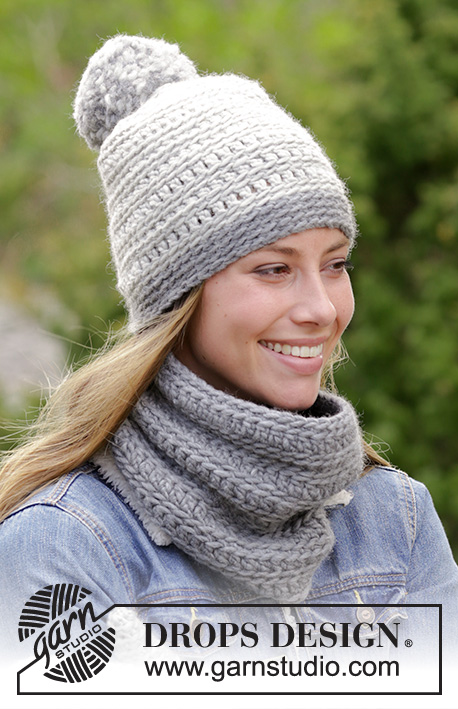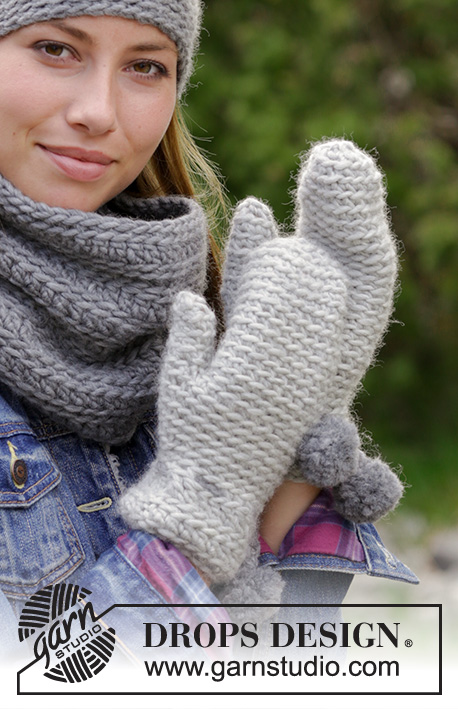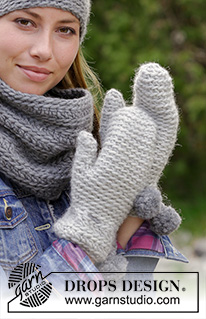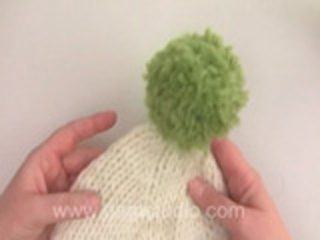Earl Grey |
|
 |
 |
The set consists of: Crochet hat, neck warmer and mittens. The piece is worked in DROPS Snow.
DROPS 182-33 |
|
|
INFORMATION FOR THE PATTERN CROCHET INFO: At the beginning of each round of double crochets, replace the first double crochet with1 chain stitch. Finish the round with 1 slip stitch in the first chain stitch at beginning of round. At the beginning of each round of half treble crochets replace the first half treble crochet with 2 chain stitches. Finish the round with 1 slip stitch in the second chain stitch at beginning of round. At the beginning of each round of treble crochets replace the first treble crochet with 3 chain stitches. Finish the round with 1 slip stitch in the third chain stitch at beginning of round. PATTERN: ROUND 1: 1 half treble crochet in the back loop of each double crochet. ROUND 2: 1 double crochet in the back loop of each half treble crochet. ROUND 3: 1 treble crochet in the back loop of each double crochet. ROUND 4: 1 double crochet in the back loop of each treble crochet. Repeat rounds 1 - 4. COLOUR CHANGE TIP (for hat): To get a neat transition when changing colours, work the slip stitch at the end of the round before starting with the new colour as follows: Insert the hook into the chain stitch worked at the beginning of the round, pick up the new strand, make a yarn over with the new colour and pull it through the loop on the hook. WORK 2 DOUBLE CROCHETS TOGETHER: * Insert the hook into the next stitch, pick up the strand (= 2 loops on hook) *, work from *-* one more time, make a yarn over and pull it through all 3 loops on hook (= 1 double crochet decreased). CROCHET TIP (for mittens): When working double crochets in the back loop of the stitch, it is easy to tighten the stitch too much, the mitten will then lose its elasticity and be too tight. Make sure the double crochets are loose enough, i.e. when making the yarn over when working double crochets, pull the yarn over all the way through the stitch (and even a little further). INCREASE TIP (for hat): To work out how to increase evenly, count the total number of stitches on the round (e.g. 40 stitches) and divide by the number of increases to be made (e.g. 10) = 4. In this example, increase 1 stitch after every 4th stitch. Increase 1 stitch by working 2 stitches in 1 stitch. DECREASE TIP (for mittens): To work out how to decrease evenly, count the total number of stitches on the round (e.g. 20 stitches) and divide by the number of decreases to be made (e.g. 4) = 5. In this example, work every 4th and 5th stitch together as described below. Decrease 1 double crochet by working 2 double crochets together as follows: * Insert the hook into the next stitch, pick up the strand *, work from *-* one more time, make a yarn over and pull it through all 3 stitches on the hook. -------------------------------------------------------- HAT: The hat is worked in the round, top down. Work a circle as follows: Work 4 chain stitches with hook size 7 mm and light grey and form them into a ring with 1 slip stitch in the first chain stitch. Read CROCHET INFO! ROUND 1: Work 12-12 half treble crochets around the ring. Now work each round in the back loop of each stitch. ROUND 2: * Work 1 double crochet in the first half treble crochet, 2 double crochets in the next half treble crochet * work from *-* to end of round = 18-18 double crochets on round. ROUND 3: * Work 1 treble crochet in the first double crochet, 2 treble crochets in the next double crochet * work from *-* to end of round = 27-27 treble crochets on round. ROUND 4: * Work 1 double crochet in the first treble crochet, 2 double crochets in the next treble crochet * repeat from *-* to end of round = 40-40 double crochets on round. REMEMBER THE CROCHET TENSION! After the circle, continue working PATTERN - see description above. AT THE SAME TIME increase 10-13 half treble crochets evenly on first round – read INCREASE TIP = 50-53 stitches on the round. When piece measures approx. 19-20 cm change to medium grey – read COLOUR CHANGE TIP. Work 4 rounds of double crochets (work in the back loop). Cut and fasten the strand. The hat measures approx. 23-24 cm from the top down. Make a large pom pom of approx. 9 cm with both colours and fasten to top of hat. -------------------------------------------------------- NECK WARMER: Work 56 loose chain stitches with hook size 8 mm and medium grey and form them into a ring with 1 slip stitch in the first chain stitch. Read CROCHET INFO! Work 1 round with 1 half treble crochet in each chain stitch. Work PATTERN in the round starting from ROUND 2 in the pattern - see description above. AT THE SAME TIME on round 6, decrease 4 double crochets evenly on round by working every 13th and 14th double crochet together – read WORK 2 DOUBLE CROCHETS TOGETHER = 52 double crochets. Continue the pattern in the round until piece measures approx. 26 cm in height – finish after a round of double crochets. Cut and fasten the strand. -------------------------------------------------------- MITTENS: The piece is worked in the round. You fist work a cuff with pattern, then the rest of the mitten with double crochets in the back loop. CUFF: Work 21-23 slightly loose chain stitches with hook size 6 mm and light grey and form them into a ring with 1 slip stitch in the first chain stitch. Read CROCHET INFO! Work 1 round with 1 half treble crochet in each chain stitch. Work PATTERN in the round starting from ROUND 2 in the pattern – see description above. When the piece measures approx. 5 cm the cuff is finished – stop after a round of double crochets. Insert 1 marker thread – THE PIECE IS NOW MEASURED FROM HERE! LEFT MITTEN: Work in the round with 1 double crochet in each double crochet - read CROCHET TIP and work in the back loop of each stitch (do this for the rest of the mitten). REMEMBER THE CROCHET TENSION! When you have worked 1 round of double crochets after the marker thread, increase 1 double crochet for the thumb on each side of the first stitch at the beginning of the round – increase 1 double crochet by working 2 double crochets in the same double crochet. Increase in this way on each side of this first stitch every 2nd round a total of 3-4 times = 27-31 double crochets on the round (7-9 of these stitches are thumb stitches). Cut the strand. The next round is worked as follows: Skip the first 4-5 double crochets on the round, work 1 double crochet in each of the next 20-22 double crochets (work in the back loop) = 3-4 double crochets left on round. Now continue with the next round without working the last 3-4 double crochets on the round. NOTE: Mark the beginning of the round with a marker thread between the last stitch on the round and the first stitch on the next round, allow the marker thread to follow your work onwards. Work 1 double crochet in each of the 20-22 double crochets (work in back loop) until piece measures 18-20 cm from the marker thread. Then decrease as follows: ROUND 1: Work 1 double crochet in each double crochet (in back loop) and AT THE SAME TIME decrease 4-5 double crochets evenly on round - read DECREASE TIP = 16-17 double crochets on round. ROUND 2: Work 1 double crochet in each double crochet and AT THE SAME TIME decrease 4-5 double crochets evenly on round = 12 double crochets. ROUND 3: Work 2 and 2 double crochets together = 6 double crochets left on round. Cut the strand, tack it up and down through the remaining stitches, tighten and fasten well. THUMB: = 7-9 stitches. The first round is worked as follows: Work 1 double crochet in each double crochet (work in back loop), in addition work 2 double crochets precisely in the transition between thumb and mitten = 9-11 double crochets on the round. Work 4-5 rounds with 1 double crochet in each double crochet. On the next round work 2 and 2 double crochets together until there is 1 double crochet left on the round, work the last double crochet = 5-6 double crochets left. Cut the strand, tack it up and down through the remaining stitches, tighten and fasten well. CORDS: Cut 2 strands of medium grey, each 120 cm long. Twist them together until they begin to resist, fold the cord double and it will continue to twist. Tie a knot in each end. Make 2 small pom poms of approx. 2-3 cm in diameter. Sew 1 pom pom to the one end of the cord. Thread the cord up and down through the stitches in the transition between cuff and mitten (the cord should start and finish on the outside of the mitten so that the pom pom is not in the palm). Sew the other pom pom to the other end of the cord. RIGHT MITTEN: Work cuff and mitten in the same way as the left mitten, but when increasing to thumb increase on each side of the last stitch on the round (instead of on each side of the first stitch). The rest of the mitten and thumb are worked in the same way as the left mitten. Make cords with pom poms in the same way as for the left mitten. |
|
|
Have you made this or any other of our designs? Tag your pictures in social media with #dropsdesign so we can see them! Do you need help with this pattern?You'll find tutorial videos, a Comments/Questions area and more by visiting the pattern on garnstudio.com. © 1982-2024 DROPS Design A/S. We reserve all rights. This document, including all its sub-sections, has copyrights. Read more about what you can do with our patterns at the bottom of each pattern on our site. |
|
















































Comments / Questions (4)
Hei, hvordan skal jeg klare å få det til å se ut som en vitt, sto veldig vanskelig i oppskriften, er på den omg hvor man skal hoppe over masker (til tommel’n). Og ikke hekle de siste 4 maskene, men hvordan skal jeg klare å få den overgangen som skiller tommel til hånda?
08.11.2021 - 10:36DROPS Design answered:
Hei Agnethe. Når du har økt alle maskene til tommelen og har 27 eller 31 fastmasker (avhengig av hvilken str. du hekler), skal du klippe tråden. Hopp over de første 4 eller 5 fastmaskene på omgangen (merketråden sitter i 1. maske). start med ny tråd. Hekle 1 fastmaske i hver av de neste 20-22 fastmaskene = 3 eller 4 fastmasker tilbake på omgangen. Nå hekler du i den første masken du startet i, på denne omgangen, altså det er 7 eller 9 masker det ikke hekles over. mvh DROPS Design
15.11.2021 - 08:37El patrón dice vuelta 1 punto medio, vuelta 2 punto bajo y vuelta 3 punto alto, y repetir las vueltas 1-4. pero el patrón sólo habla de 3 vueltas. me puedes explicar?
27.10.2020 - 18:55DROPS Design answered:
Hola Tania. Tienes razón. Ha sidp una errata al publicar el patrón. VUELTA 4: Trabajar 1 punto bajo en el bucle posterior de cada punto alto.
01.11.2020 - 13:03Grazie molto chiara mi ero persa in un bicchiere d'acqua ora mi sento più sicura...
06.01.2019 - 16:52Ho comprato la lana e vorrei iniziare il berretto ma non ho capito al primo giro cosa significa 12/12 mezze maglie? Poi dice 18/18 maglie basse al secondo giro? Potete darmi dei chiarimenti vi ringrazio
06.01.2019 - 16:39DROPS Design answered:
Buongiorno Francesca. I numeri fanno riferimento alle maglie da lavorare a seconda della taglia. Per la taglia S/M deve considerare il primo numero , per la M/L il secondo numero. Quindi se la sua taglia è la S/M, al primo giro lavora 12 mezze maglie alte e alla fine del secondo giro deve avere 18 maglie basse. Buon lavoro!
06.01.2019 - 16:49